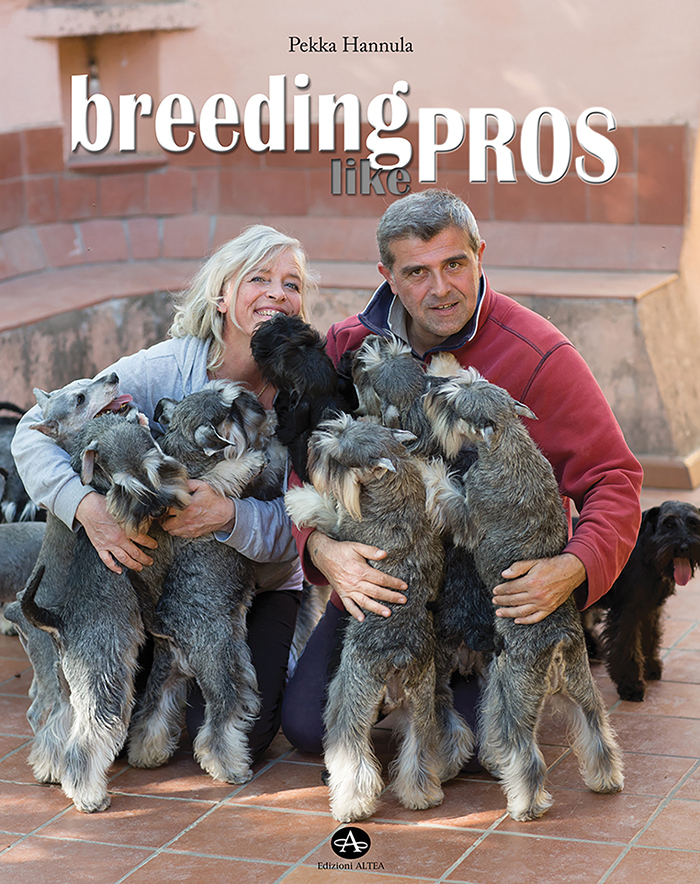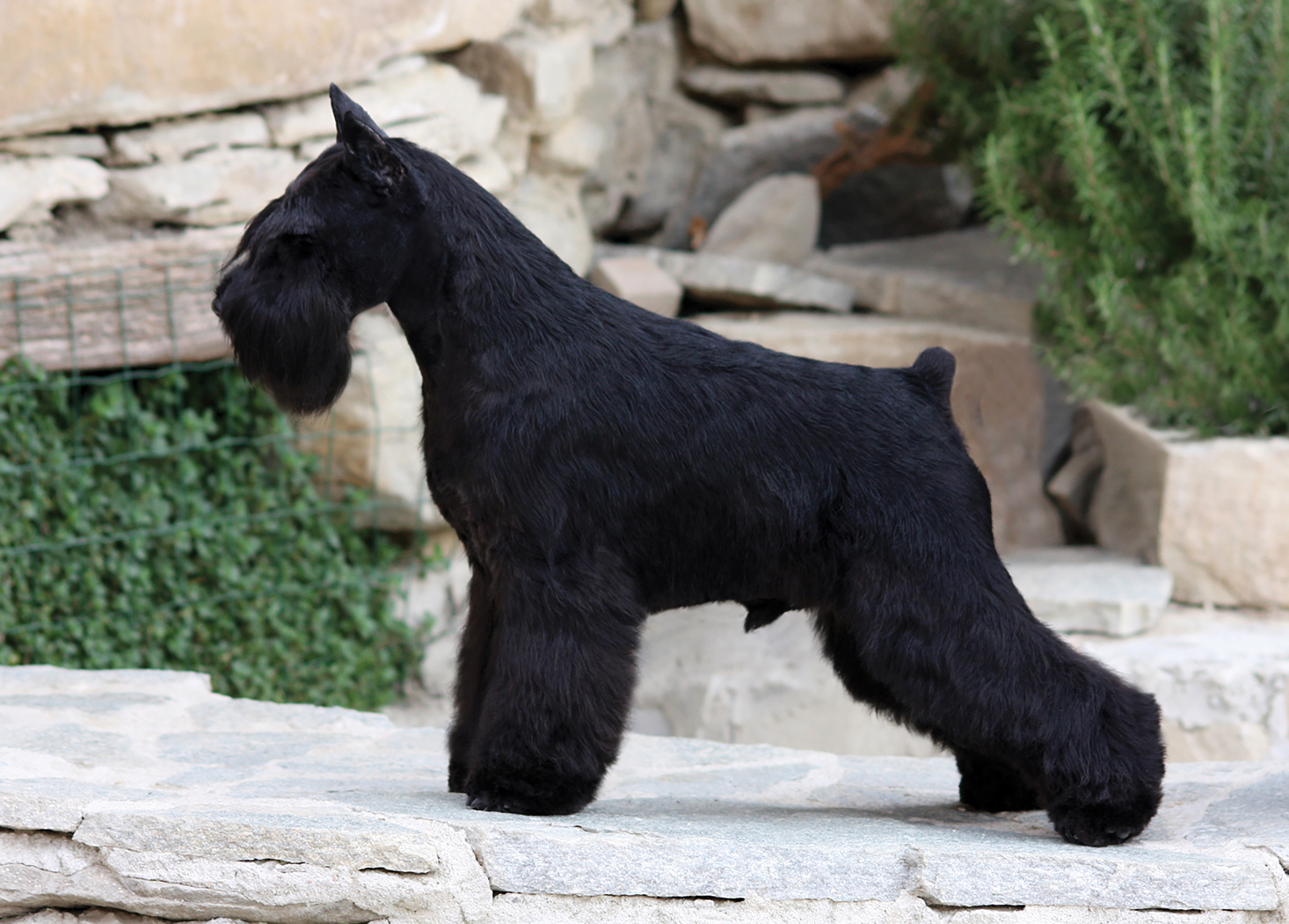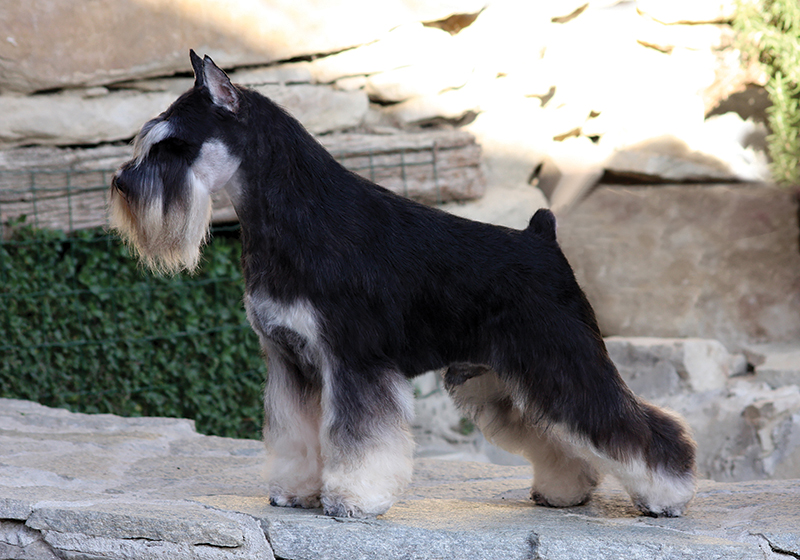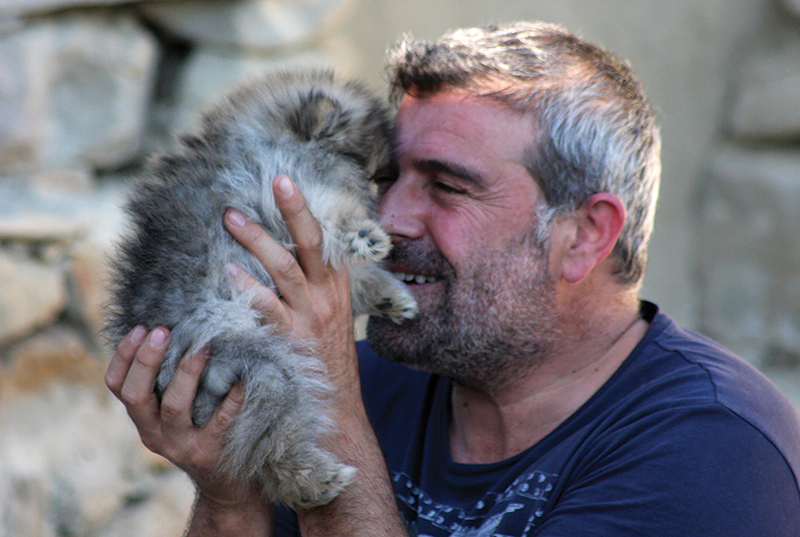Breeding by Pros by Pekka Hanula • Mia and Fabrizio
Literary Dog • Anne Tureen
Pekka Hannula, from Finalnd, has written a number of books on breeding, judging, and handling. He has just come out with his latest work, Breeding Like Pros (2018, Altea Pub). This is nearly 300 pages of material on breeding, caring for and showing dogs as interpreted by Mia Ejerstad and Fabrizio Bocchino. Mia has literally been in dogs since she was 7 years old, and Fabrizio began at about the same age, so there is a lot of experience packed into each chapter! They hold nothing back from Pekka as they discuss every aspect of their life, from morning to night in the kennel, grooming and training their dogs, going to shows and their thoughts on shows, judges, and most of all- breeding.
One chapter takes a look at the modern kennel facilities they have just built slightly north of Rome in Italy. Mia shares her layout to which all of her experience has contributed and discusses in detail each choice from fencing to gravel. A full chapter is dedicated to her nutrition plan, an issue to which she has always dedicated much thought. She has, over decades of research and experimentation, worked out her own way to provide balanced fresh nutrition for a kennel full of dogs, which she explains fully.
Althea has produced a quality edition, in a handy format. The design and photos are especially well done, though some of the dark photos, for example in the photos of a beautiful black Pomeranian, are difficult to make out. There are poetic images of the place and people and the activities of this kennel that bring to life the text that is characterized by Mia’s contagious energy. The text that has been written in English has some rough patches, but the content is thick with good advice from the voice of experience.
Pekka Hannula.
Q: Pekka, this book is a noteworthy addition to your long list of great books. In a way it is your ‘masterwork’ because it addresses many different subjects. How did you plan it?
A: I met Mia and Fabrizio when they stayed in our house for a week during the WDS Helsinki 2014. I know a lot of dog people, but I never met such pros. We had hot weather at that time, but she trained handlers on exactly what to do eight hours on one day. Then Mia decided which dog fit best to each handler. And the grooming! Wow!
During the show days they woke up at 3 am to be the first ones on the line when the doors opened. Since they had a lot of dogs, they also needed space. One morning Fabrizio asked if they could sleep half an hour more. Mia just said to him “we have travelled here 3000 km and you want to sleep an extra half an hour?”. I have never seen anything so professional in my life. I have been breeding for decades, but felt myself a total amateur. I knew I wasn’t the only one who would feel that way if they had seen that.
But the idea of the book didn’t start right then (or who knows what the subconscious produces). First, I had the idea of a book on great breeders, but right after that I knew the only people who would be the best for that – Mia and Fabrizio.
Q: What was the atmosphere like while you were working on the book with Mia and Fabrizio?
A: During the interviews they were just like they are, professional. Very intensive! They have a lot of dogs to take care of so no time to waste. But we had our funny moments like when Mia me about the time she met Fabrizio.
The questions – and they are the key – came easily. Also, because I wanted to know the answers. The questions follow always the topics I have already addressed in different books. If they are interesting and not trivial, the answers are interesting. Of course, every writer has their own technique.

Q: You use several techniques in presenting the material, summary, one on one interview, three way interview and journalism. What do you think are the advantages of each?
A: Oh, I have experimented with them all over the years, and like a painter I choose between them as between working in pencil, oil or watercolor, I goes with what feel right for the job.
Q: You had Swedish, Finnish, Italian and some English going on, how did you manage the languages?
A: Fabrizio knows a lot and has a lot to say. So it was obvious that he had to have a chance to use his mother language. It was not an obstacle, because Mia, such a bright person, could translate everything immediately.
Q: There are a huge amount of photographs in this book, that must have been a Herculean job to sort out!
A: I visited their place twice, first in June and again in August and we looked through some pictures. However, the actual work of sorting them was made by Mia, Fabrizio and the publisher Barbara Ferratini.
Q: There were many different breeds involved: Collies, Schnauzers, Jack Russells and more, there must have been a lot going on?
A: They are breeding several breeds. For the reader it’s only a benefit, because comparing them gave a wider scope to the book. They also have every age, prenatal mothers, puppies of all ages, then the young adult and veteran dogs, not to mention the huge guard dogs, thank goodness Mia is a consummate trainer!
Q: Mia and Fabrizio have been moving around Europe, but I think they have found a permanent home now. Tell us a little about the kennel, and how they planned and executed their ideas.
A: They have the best facilities one could imagine. Every detail has been thought over,
the huts of the dogs, the ground made out of stones. Everything has its place and is spacious without being a ranch or anything like that. It is very well planned. Impressed is not the right word. Stunned is better! Wow! One major difference between Mia and other handlers is that she is both a professional handler and a Breeder owner handler!
I think she just wins, with others and with her own dogs! She has learned a lot from other breeds which she has handled too. She is smart and skillful in both breeding and handling.
Q: Tell us a bit about yourself, how did you get into writing and the dog world?
A: I’m a biologist by education, but nowadays a writer. I also have been a breeder, handler and a judge for decades. But when those started to feel repetitive, I wanted to start sharing the ideas and angles I had seen. But not just to the dog world. I have written a series of books of biology, customer service and other subjects.
Q: Do you have anything ‘in the oven’ for an upcoming book?
A: I have one more dog book coming. Pretty slowly though!
Then I will write with my good friend a book on Fishing the Pike. We were joking that when the time comes – maybe not soon – we can read extracts of this long book at the funeral if one of us dies before it’s finished!
But then I am working on two REALLY important books with which I try to get children to read more and play on their mobile phones less. They are an adventure book for teenagers and a book of bed time stories for small children. In that one I try to feed the imagination of small children so that they later value books as a source of life in their heads.
Q: It must have been nice seeing Pekka again? Because creating Breeding Like Pros, was not your first collaboration with him?
A: Yes, Pekka and I have known each other for some years. I collaborated for his books “Keys to Top Handling”, and “Keys to Top Breeding Vol 2” – and now, this one “Breeding Like Pros”, where I and Fabrizio are the “main subjects”. I might be more well-known to some as “Mia the handler”, who don’t know my real background in the dog world. But in this book, I and Fabrizio were able to speak about breeding, which was my first love, and I would say has always been my greatest interest. We all should never forget that, without top breeders there would be no top dogs…neither to show nor to groom! So, one objective of this book is to share our experiences in a lot of aspects regarding breeding, what we do and the decisions Fabrizio and I make when breeding. Today there’s a huge amount of information available and sharing through internet and social media is one of the main forums nowadays, but it is necessarily brief. There is a lot to say about breeding that will never fit into a ‘post’ – and it’s here in the BOOK its rightful place. But even in a book there will not be “enough” of space to put down everything, of course.
So, even if there are topics that we could have gone deeper into, or some topics are hardly touched upon, I hope that, what we wrote will stimulate other breeders, because they can make comparisons with their own ideas and thinking. One thing that will probably come across, is that we take a very traditional approach to selection. Testing for health is very important, but one should never forget to take a closer and honest deep look at the dog itself. It is here, where it all begins. We always put much emphasis on breed essence and breed specific points. Type and essence are the first considerations. With Swedish, Italian, English language – then different breeds like Schnauzers, Collies, Shelites, Poms and all the others – you guys had a lot going on…
It was Babylon! Fortunately, our connecting language was English. Because Pekka’s Finnish is a language of its own, but he knows English and also some Swedish – but no word of Italian. I can manage enough in both Italian and English, but my native language is Swedish. English is obviously “only” a second language for both Pekka and me, so while in the end everything worked out very well, it was really more time consuming than we expected. The recording of the interviews and the writing was done in English, but with instant translations to Italian for Fabrizio and vice versa to Pekka… It wasn’t easy for myself to be there in the middle of everything! My father is a professional translator, and as he says, something is always lost, or at least not equal to the original, in translation. What made it all keeping together and making it possible and feeling worthwhile, was our passion for dogs!

Q: Which part of the book is your favorite?
A: I have to say I am well satisfied with everything, but perhaps the ‘Name Game’ was the most fun to do and in a way a “lighter” chapter.
Q: Did you get any interesting feedback while signing copies at Crufts?
A: I was only available on the Saturday, and the books sold out so fast, but it was great speaking with some of the readers. Many remarked on the great passion that transpires the whole book and that is inspiring the reader. Another thing I heard, was the appreciation of the simplicity of the writing. People who are not native English speakers liked the fact that the language in the book was very clear.
Q: There is a chapter in the book about how to plan your kennel facilities.There were a number of obstacles you had to overcome to get the kennel facilities at your new home started. Are there things you would do differently now that would have made it all easier?
A: One thing everyone has to do, is to deal with the limitations that the site and preexisting buildings and terrain present. In my mind, I can build castles, but when you buy a property, it will have certain characteristics that must be taken into consideration. But that is also a kind of challenge – to make and create “that” place into “your” place for you and your dogs. To find valuable solutions and make the best out of what you have!
Many things worked out as we had thought when doing the plan of the kennel. Other things we have of course been modified after having lived here now for a couple of years. For example, in order to keep the runs clean and dry, we put down some more outdoor tiles in some places, and we shored up the gravel in certain areas with bars. Keep in mind that we built our kennel for our own breeds. While I think most breeds would be well kenneled in a structure like ours, a Husky could jump our fencing in a heartbeat, so there is no universal perfect kennel for “all breeds”. Our goal was to make our kennel facilities fitting into our home, and not give the feeling of a “prison”, neither for the dogs nor for the people. We have about 100 dogs at any given time, some veterans, some in the middle of their show career, some pregnant and then pups and youngsters of all ages. We had to keep in mind so many different criteria – and special consideration given to “bad weather days”. It’s easy to make your kennels work well in good weather conditions, but one must absolutely think about those really bad weather days and how to find good solutions.
Another thing we designed for is not just good kenneling, but optimal conditions for show dogs. In that respect, using the facilities correctly is important. For example, the young dogs do not stay outdoors all day long. They have a bit more “controlled” and regulated life style. They are taken out three times a day, staying outdoors several hours every time. This is time consuming, but important mainly for two reasons. First, I want to get my hands on the youngsters, every day and several times a day, and this is actually where they do some important learning. When I come get them, and we walk, and then at meal times, they get their “every-day-education”, they learn to listen and to be attentive to you, and I also expect them to behave in an orderly way. Mind you, Schnauzers are an amazing breed, so sturdy, so smart, but I would still do this with any breed. The second reason I don’t allow the youngsters to remain out all day, is that they get wild or bored depending on each individual, and they act up digging and roughhousing. This ruins the coat, beards and furnishings, which we take care to maintain (and much time to regrow if ruined) as these youngsters are our future “show prospects”. But, youngsters are youngster in every sense, just like any specie, and they absolutely need enough space and time to be able to play and run around with each other. But on the other hand, they also need to be able to relax in-between!

Q: Which part of the kennel plan was the most challenging?
A: The solutions for the bad weather days as I said. Outdoors we have grass and gravel; the grass of course is not practical if there is rain, but it’s nice, not only to look at but also to walk on, both for us and for the dogs. So, we have a first outdoor space near the indoor area that is covered so the dogs can be outside if they wish, whether there is sun or wet and they will not be affected. Each of these covered yards connects to another graveled and partly paved area, and then again to an even larger open space that we use in good weather. They can really run and play there. In addition, we also have several another huge runs, where the dogs are allowed, weather permitting, to stay and play in even bigger groups.
Then, there is the constant challenge of cleaning. I like my kennel to feel really clean, indoors and outdoors. My whole morning is dedicated to cleaning and feeding, which leaves the afternoon for grooming and some show training. But show training is also done in the everyday life with the dogs. Every time I am with a dog, we are actually communicating. Every time I put a dog on the table, for example, the show posing and stacking is trained automatically. When taking a dog on the leash, this is also a time for training – and that is especially asking him to give me his attention, whether moving or standing. This way of “natural every-day training” has become such a normal thing for me, that when I hold my workshops, sometimes I forget to point out some behaviors or ways of doing something, because they have become such ingrained habits that I don’t even think about them.
Q: Has anything changed since you settled in the new kennel?
A: I’m always exhausted at the end of the day, that hasn’t changed! I love to do things, I love to work, and especially with the dogs, I hate to do “nothing” …! Sometimes I feel what we do with our dogs is not enough, even though we are completely dedicating our lives to them! But then, when a family comes for one of our puppies or youngsters, they call us the next day and say, ‘It feels like this dog has always been with us!’ That makes us so happy. That means that our dogs have got the right up-bringing, and first and foremost that they are trusting humans and are willing to go out into life with a positive attitude. Our dogs are very selectively bred, they are balanced and satisfied, and well-conditioned both physically as mentally, so what more could one ask for? Breeding like pros, in our way of thinking, breeding selectively for quality in a dedicated “professional” and responsible way.




